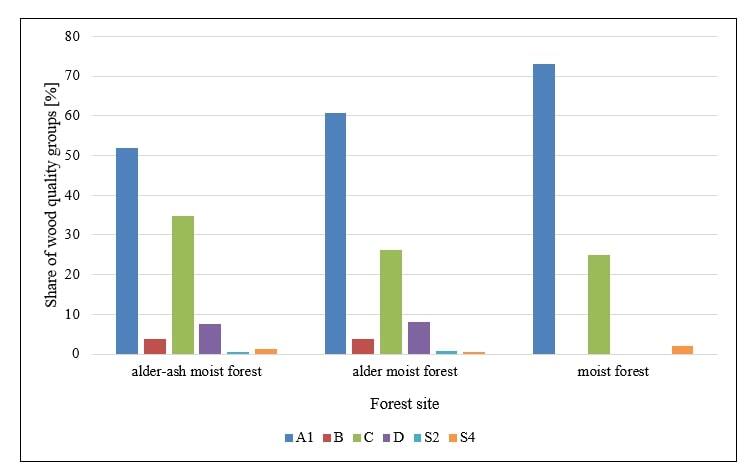Archive
Online first
Current issue
Instructions for Authors
Guide for authors
Peer Review Policy
Research Ethics Policy
Crossmark Policy
Ghostwriting and Guest Authorship
Copyright
Open Access Policy
Plagiarism
About the Journal
Aim and Scope
Scientific Board
Publisher
Editorial Board
Indexing in databases
Personal Data Protection
Repository policy
Contact
ORIGINAL PAPER
The quality of alder raw material from stands growing in different habitats
1
Department of Forest Utilization and Forest Techniques, Faculty of Forestry,
University of Agriculture in Krakow, Poland
2
Department of Forest Resources Management, Faculty of Forestry, University of Agriculture in Krakow, Poland
Submission date: 2024-11-15
Final revision date: 2025-01-14
Acceptance date: 2025-01-29
Online publication date: 2025-03-25
Corresponding author
Krzysztof Michalec
Department of Forest Utilization and Forest Techniques, Faculty of Forestry, University of Agriculture in Krakow, Al. 29 Listopada 46, 31-425, Krakow, Poland
Department of Forest Utilization and Forest Techniques, Faculty of Forestry, University of Agriculture in Krakow, Al. 29 Listopada 46, 31-425, Krakow, Poland
Drewno 2025;68(215)
KEYWORDS
decaywood defectsfalse heartwoodwood classificationspecial woodalder moist forestalder-ash moist forestmoist forest
TOPICS
ABSTRACT
In the present study, an attempt was made to determine the quality of alder raw material growing in different habitat types of forest. The research work was conducted in the Włoszczowa Forest District in Poland. Measurements were taken in 8 stands growing on three forest site types: alder moist forest, alder-ash moist forest, moist forest. In the selected stands, 4-are sample plots were established. In each circular sample plot, DBH and height of all trees in the plot were measured. In the selected trees, the quality of the wood and the type of defects that influenced the wood classification result were determined in the trunk butt end (at a length of 4 metres). In every other plot, a core was taken from a height of 1.3 m in a randomly selected tree to determine the presence of latent defects. The black alder tested on each site achieved very good technical quality. The volume share was dominated by veneer wood, the most of which was estimated in moist forest. Very small amounts were found of lower quality classes. It was found that in less humid habitats than typical alder forests, black alder produces better quality wood. However, once the borings were taken into account, the proportion of each quality class changed dramatically. Hard rot and soft rot degraded the best quality classes to lower quality classes. The share of the best quality wood fell from 60% to 7.57%, while the share of the worst quality wood increased from 5.94% to 40.57%.
REFERENCES (17)
1.
Arhipova N. [2012]: Heart rot of spruce and alder in forests of Latvia. Acta Universitatis Agriculturae Sueciae. Doctoral Thesis. Swedish University of Agricultural Sciences, Uppsala 48 pp.
2.
Arhipova N., Gaitnieks T., Donis J., Stenlid J., Vasaitis R. [2012]: Heart-rot and associated fungi in Alnus glutinosa stands in Latvia. Scandinavian Journal of Forest Research 27: 327-336. DOI:10.1080/02827581.2012.670727.
3.
Aydin I., Colakoglu G. [2005]: Effects of surface inactivation, high temperature drying and preservative treatment on surface roughness and color of alder and beech wood. Applied Surface Science 252: 430-440. DOI:10.1016/j.apsusc.2005.01.022.
4.
Białobok S. [1980]: Olsze. Alnus Mill. Nasze drzewa leśne. Monografie popularno- naukowe. PWN, Warszawa Poznań, Tom 8. 350 pp.
5.
Bleive A., Liepins J., Liepins K. [2022]: Internal decay assessment using drilling resistance in mature common alder (Alnus glutinosa (L.) Gaertn.) stands. Research for Rural Development 37: 37-43. DOI: 10.22616/rrd.28.2022.005.
6.
Claessens H., Oosterbaan A., Savill P., Rondeux J. [2010]: A review of the characteristics of blackalder (Alnus glutinosa (L.) Gaertn.) and their implications for silvicultural practices. Forestry 83 (2): 163–175. DOI: https://doi.org/10.1093/forest....
7.
Czuraj M. [2000]: Tablice miąższości drewna okrągłego. (Thickness tables of round wood). Multico, Warszawa.
8.
Johansson T. [1999]: Dry matter amounts and increment in 21- to 91-year-old common alder and grey alder and some practical implications. Canadian Journal of Forest Research, 29: 1679-1690.
9.
Karaszewski Z., Mederski P. S., Bembenek M., Giefing D. F., Sawicka K., Gierszewska M. [2015]: Factors affecting the timber quality of black alder (Alnus glutinosa (L.) Gaertn.). Annals of Warsaw University of Life Sciences – SGGW Forestry and Wood Technology 89: 70−75.
10.
Kot S. M., Jakubowski J., Sokołowski A. [2007]: Statystyka. (Statistics). Difin. Warszawa. 520 pp.
11.
Laurow Z. [2003]: Drewno ważniejszych gatunków drzew. Gatunki liściaste. 8. Olcha (Wood of important tree species. Deciduous species. 8. Alder). Przemysł Drzewny 54 (6): 28.
12.
Miklašēvičs Z. [2021]: Review of characteristics of Alnus glutinosa stands quality according to forest types and ages. Environment. Technology. Resources. Rezekne, Latvia, Proceedings of the 13 th International Scientific and Practical Conference. Vol. 1: 170-177. DOI: doi: 10.17770/etr2021vol1.6610.
13.
Rohumaa A., Kallakas H., Mäetalu M., Savest N., Kers J. [2021]: The effect of surface properties on bond strength of birch, black alder, grey alder and aspen veneers. International Journal of Adhesion and Adhesives 110: 102945. DOI: https://doi.org/10.1016/j.ijad....
14.
Salca E.−A. [2019]: Black alder (Alnus glutinosa L.) – a resource for value−added products in furniture industry under European screening. Current Forestry Reports 5: 41−54. DOI: https://doi.org/10.1007/s40725....
15.
Statistics Poland [2023]: Leśnictwo. (Forestry). GUS. Warszawa, Białystok. 348 pp.
17.
Usta A., Yılmaz M., Kahveci E., Yılmaz S., Öztürk H. [2014]: Effects of different site conditions on some of the wood properties of Black alder (Alnus glutinosa (L.) Gaertner subsp. barbata (C.A. Meyer) Yalt). Fresenius Environmental Bulletin 23 (8): 1840 – 1851.
We process personal data collected when visiting the website. The function of obtaining information about users and their behavior is carried out by voluntarily entered information in forms and saving cookies in end devices. Data, including cookies, are used to provide services, improve the user experience and to analyze the traffic in accordance with the Privacy policy. Data are also collected and processed by Google Analytics tool (more).
You can change cookies settings in your browser. Restricted use of cookies in the browser configuration may affect some functionalities of the website.
You can change cookies settings in your browser. Restricted use of cookies in the browser configuration may affect some functionalities of the website.



